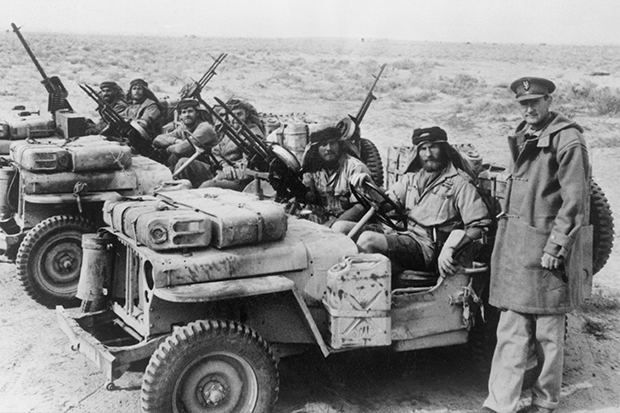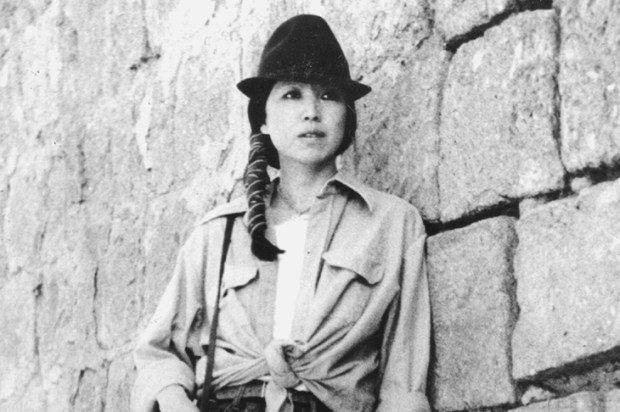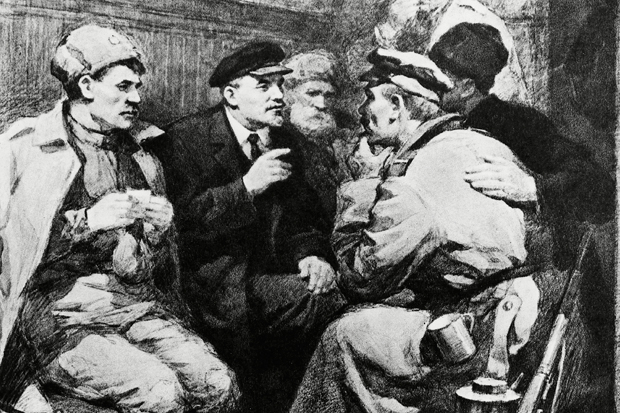The SAS was the first unit to be granted regimental status for generations. Its chief aim was to damage the enemy from behind their lines in the North African desert. It was an entirely independent unit, not answerable to any superior command and therefore anathema to the regular army mind. Its creator, David Stirling, had a record of complete allergy to discipline or serious work either at school at Ampleforth or later, briefly, at Cambridge, where the Master of his college sent him down after showing him a list of 28 transgressions and asking him to choose the three which ‘would be the least offensive to his mother’.
In 1940 he found himself fretting in reserve in Egypt in the group of three commando regiments recruited from the Household Division under Colonel Robert Laycock, code-named ‘Layforce’. Stirling’s first parachute jump left him unable to walk for eight months, which he spent studying every map he could find of the coastal strip and the area behind it. He thus formed a plan for working behind the enemy lines. By a great stroke of luck he had access to General Auchinleck, then Commander in Chief, Middle East Command, and was able to bypass all the intermediate levels of command which would certainly have sent him packing. He was then authorised to raise a force of six officers and 60 men, originating from Layforce which had by then been disbanded.
Their training was uniquely rigorous. Apart from parachuting, it included explosives, map reading, radio operating, first aid (including amputation in the field), navigation and intensive weapon training, memory training and, most daunting of all, night marches of up to 100 miles ‘with full load’. Their first sortie was a complete disaster, largely because of appalling weather conditions which would have caused a less obstinate commander to postpone operations. Of the 55 men who set out, only 21 returned, without having fired a shot or planted a single bomb.
But another maverick unit, the Long Range Desert Group took the survivors back to the Eighth Army forward base, and it dawned on Stirling that if the LRDG could get them out from a raid it could equally get them in. Luckily their next raid, on the enemy airfield at Sirte, went much better, in spite of Stirling treading on a sleeping Italian soldier in the dark. Sixty enemy aircraft were destroyed on the ground, 60 enemy killed or wounded and a large ammunition dump blown up, without the loss of a single SAS man.
On the next raid no fewer than 90 planes were destroyed, which would otherwise have been attacking the convoys attempting to relieve the battered but crucial British base at Malta. A further raid attacked Benghazi, and Randolph Churchill, the Prime Minister’s son, was allowed to come along as an observer. In his most constructive action in the entire war, he reported back so enthusiastically that the PM sent for Stirling to dine with him in Cairo. The SAS was anyway just the kind of daring sideshow that Churchill loved (usually with disastrous results).
Stirling joined the PM, General Alexander and Field Marshal Smuts for dinner and afterwards asked them to autograph a piece of paper as a souvenir. Later Stirling had no hesitation in typing in, above the signatures the words, ‘Please give the bearer of this note every possible assistance,’ epitomising the audacity and blind courage which were the hallmarks of SAS operations throughout.
Stirling then asked the new C-in-C, Montgomery, for 150 more men to supplement his attacks. Monty refused dismissively, but later relented, commenting:
The Boy Stirling is quite, quite mad. However, in war there is often a place for mad people… Penetrating miles behind the enemy lines… on a 400-mile front. Who but the Boy Stirling could think up such a plan?
At the end of 1942 Stirling got his way and a second force, 2SAS, was formed under Stirling’s elder brother Bill, with a Special Boat Squadron, appropriately under Lord Jellicoe, who became for a time a government minister after the war.
But there was a severe problem. ‘Stirling was a born organiser who disliked administration… an officer of vaulting ambition who now saw his creation expanding out of his sole control.’ He was taken prisoner on a typically dangerous mission and removed to Colditz. Rommel had had his eye on the SAS for some time and called him ‘the very able and adaptable commander of the desert group which has caused us more damage than any other unit of equal size’.
After the invasion of Italy, more was achieved on roughly the same lines. After D-Day, attempts were made to cooperate with the French Resistance, who were often more concerned with killing each other, with a view to political domination after the war, than with damaging the Germans, who regularly went in for murderous reprisals against innocent villages when attacked.
The death-or-glory days were over, and although there were still raids behind the German lines, those lines were generally in retreat, and the SAS were sometimes in danger from friendly fire as the Allies advanced.
Parts of this thrilling story have been told before, but never with comprehensive access to the reports, letters, diaries and photographs in the possession of the SAS itself, and to surviving friends and families of the colourful, often semi-crazy heroes of the regiment. Ben Macintyre is the ideal narrator, both for his adroit handling of the wide range of material and the appropriate panache of his style.
After the war, the SAS produced several children. Its ethos was continued in the creation of similar units in Canada, New Zealand, Australia, France, Belgium and Israel. And as late as 1989 Stirling sent the following message to the sergeants’ mess:
Let me remind you that you must never think of yourselves as an elite. You are something more distinguished… with a special strategic role which is probably unique among all the armies of the world, and one which could save an incalculable number of lives. Hence the need for you to keep a low profile, for reticence, and for the practice of security at all times.
The post Derring-do in the desert appeared first on The Spectator.
Got something to add? Join the discussion and comment below.
Get 10 issues for just $10
Subscribe to The Spectator Australia today for the next 10 magazine issues, plus full online access, for just $10.
You might disagree with half of it, but you’ll enjoy reading all of it. Try your first month for free, then just $2 a week for the remainder of your first year.














Comments
Don't miss out
Join the conversation with other Spectator Australia readers. Subscribe to leave a comment.
SUBSCRIBEAlready a subscriber? Log in